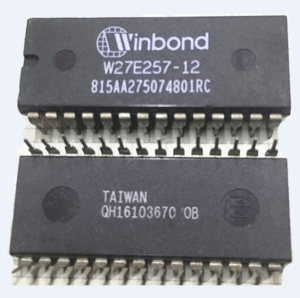
EEPROM (Electrically Erasable Programmable Read-Only Memory) is a non-volatile memory technology that retains data without power and allows byte-level erasure and reprogramming. Unlike its predecessor, EPROM (which requires UV light for erasure), EEPROMs are modified electrically, making them essential for storing configuration data, calibration settings, and other critical parameters in embedded systems, consumer electronics, and industrial applications.
Table of Contents
ToggleHistory of EEPROM
The first EEPROM was developed in 1978 by George Perlegos at Intel. By using a thinner oxide layer in transistors, Perlegos enabled electrical erasure, revolutionizing memory technology. Early EEPROMs had limited capacity (e.g., 1Kbit) and endurance, but advancements in semiconductor processes have since improved density, reliability, and affordability.
How EEPROM Works
Core Technology
- Floating Gate Transistor: EEPROM cells use a floating gate MOSFET. Charging or discharging this gate alters the transistor’s threshold voltage, representing binary data (0 or 1).
- Write/Erase Mechanisms:
- Fowler-Nordheim Tunneling: Electrons tunnel through a thin oxide layer when a high voltage is applied, modifying the gate’s charge.
- Hot-Carrier Injection: Electrons gain sufficient energy to cross the oxide barrier (less common in modern EEPROMs).
- Read Operation: A voltage is applied to the gate, and the resulting current determines the stored bit.
Key Features
- Byte-Level Erasure : Unlike Flash memory ( which erases blocks), EEPROM allows individual bytes to be rewritten.
- Endurance: Typically 100,000 to 1,000,000 write cycles per cell.
- Data Retention: Up to 10 years at room temperature.
Types of EEPROM
- Interface:
- Serial EEPROM: Uses protocols like I²C, SPI, or Microwire. Popular for compact designs (e.g., Microchip’s 24LC series).
- Parallel EEPROM: Offers faster access via a wider data bus but requires more pins (e.g., 28C256).
- Integration:
- Standalone: Dedicated ICs (e.g., STMicro’s M24 series).
- Embedded: Integrated into microcontrollers (e.g., Atmel AVR’s EEPROM).
- Specialized Variants:
- Smart Card EEPROM: Enhanced security for SIM cards.
- Automotive-Grade: Operates in extreme temperatures (-40°C to +125°C).
Applications of EEPROM
- Consumer Electronics: Storing TV channel settings, IoT device configurations.
- Automotive: Odometer data, ECU parameters.
- Industrial: Calibration data for sensors, PLCs.
- Medical Devices: Patient monitoring settings.
- Smart Cards: Secure data storage in credit cards and access keys.
Advantages vs. Disadvantages
| Advantages | Disadvantages |
|---|---|
| Non-volatile, byte-level updates | Limited write cycles (wear-out) |
| Low power consumption | Slower write speeds (~ms per byte) |
| No external circuitry for erasure | Higher cost per bit vs. Flash |
| Wide operating voltage (1.8V–5.5V) | Smaller capacities (typically ≤1Mb) |
Comparison with Other Memory Types
| Parameter | EEPROM | Flash | EPROM | FRAM |
|---|---|---|---|---|
| Erase Method | Electrical | Block Electrical | UV Light | Electrical |
| Endurance | 10⁵–10⁶ cycles | 10³–10⁵ cycles | ~1,000 cycles | 10¹⁰ cycles |
| Erase Granularity | Byte | Block | Chip | Byte |
| Cost | Moderate | Low | Low | High |
| Use Case | Small, frequent writes | Bulk storage | Legacy systems | High-endurance apps |
Key Manufacturers
- Microchip: 24LC (I²C) and 25AA (SPI) series.
- STMicroelectronics: M24 and M95 series.
- ON Semiconductor: CAT24C (automotive EEPROMs).
- Renesas: Industrial and automotive-grade EEPROMs.
Selection Criteria
- Capacity: Ranges from 1Kbit to 1Mbit; choose based on data needs.
- Interface: I²C (low pin count) vs. SPI (speed).
- Endurance: Critical for high-write applications (e.g., data logging).
- Voltage: Match the host system (e.g., 3.3V or 5V).
- Temperature Range: Commercial (0–70°C) vs. industrial/automotive.
- Package: DIP, SOIC, or TSSOP for space-constrained designs.
Future Trends
- Higher Density: Leveraging 3D stacking for increased capacity.
- Improved Endurance: Advanced materials to extend write cycles.
- Integration: Combining EEPROM with sensors/controllers in SoCs.
- Emerging Alternatives: Competition from MRAM/FRAM, though EEPROM remains cost-effective for niche uses.
Conclusion
EEPROMs are indispensable for applications requiring reliable, byte-level non-volatile storage. While Flash dominates bulk storage, EEPROM’s flexibility ensures its relevance in automotive, industrial, and IoT systems. By understanding its strengths and limitations, engineers can effectively integrate EEPROM into designs requiring frequent, small-scale data updates.
- Everything You Need To Know About Limit Switch - May 21, 2025
- Everthing You Should Know About Rheostat - May 20, 2025
- Everything You Need To Know About Reversing Contactor - May 19, 2025






